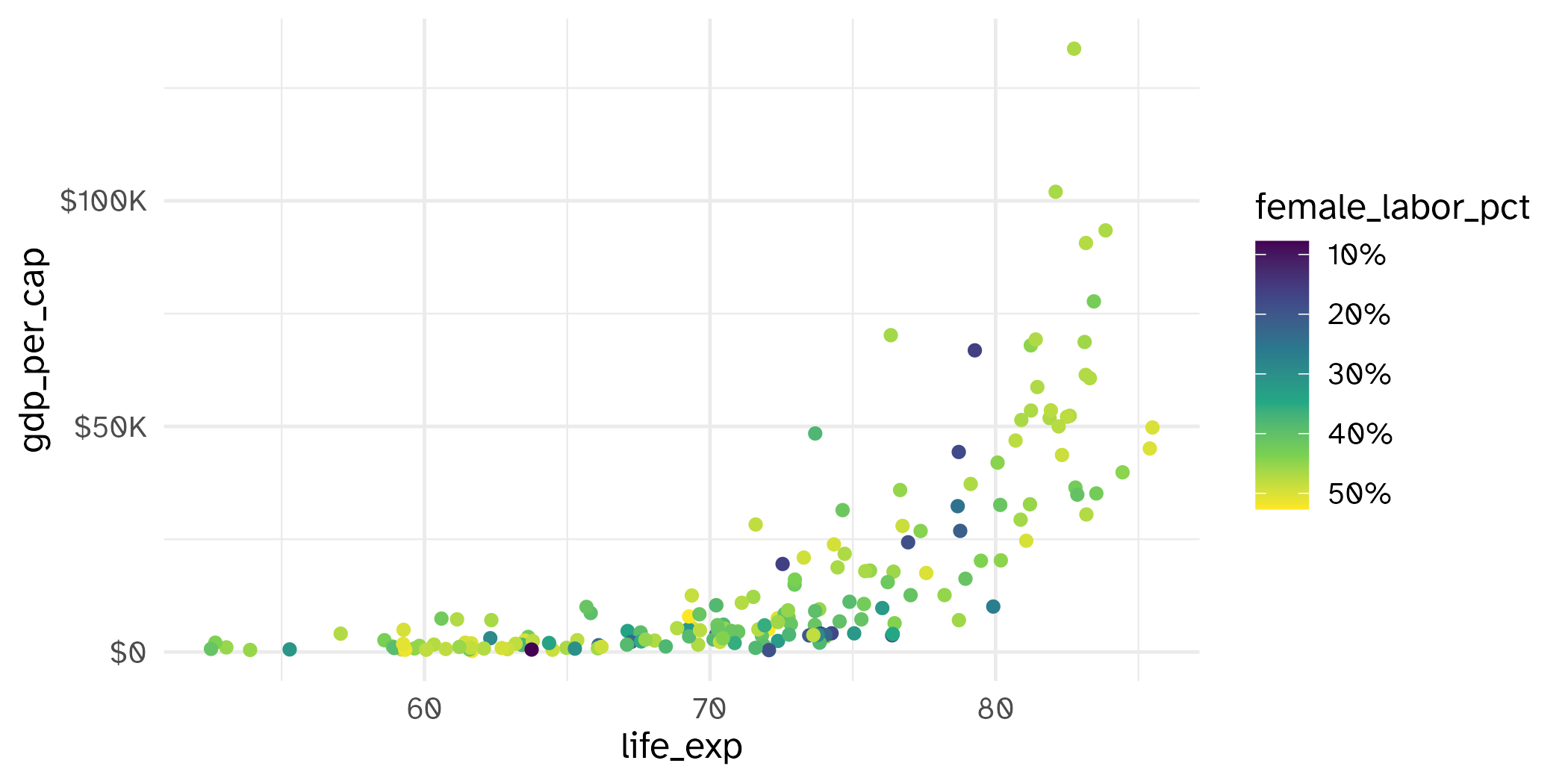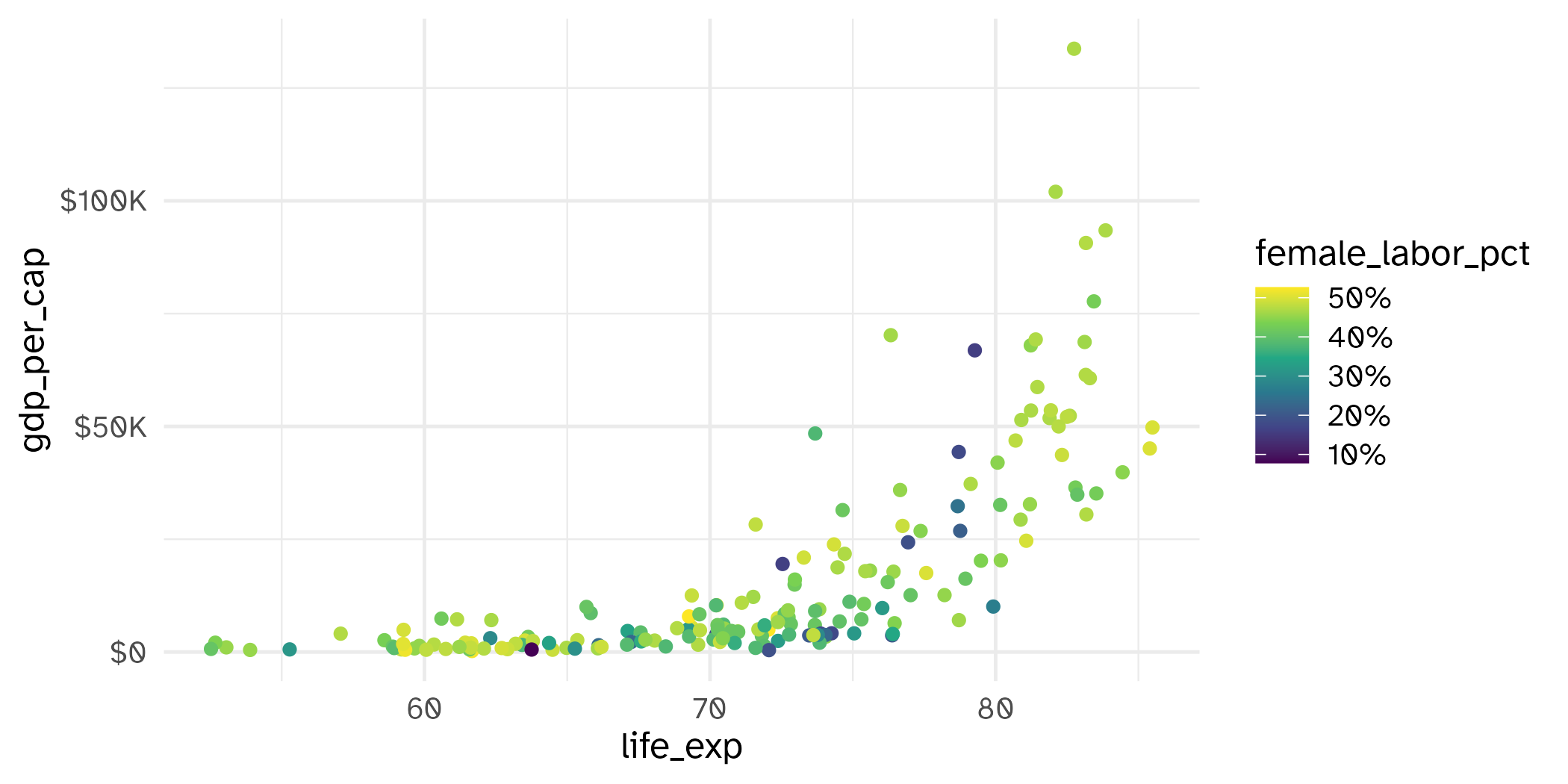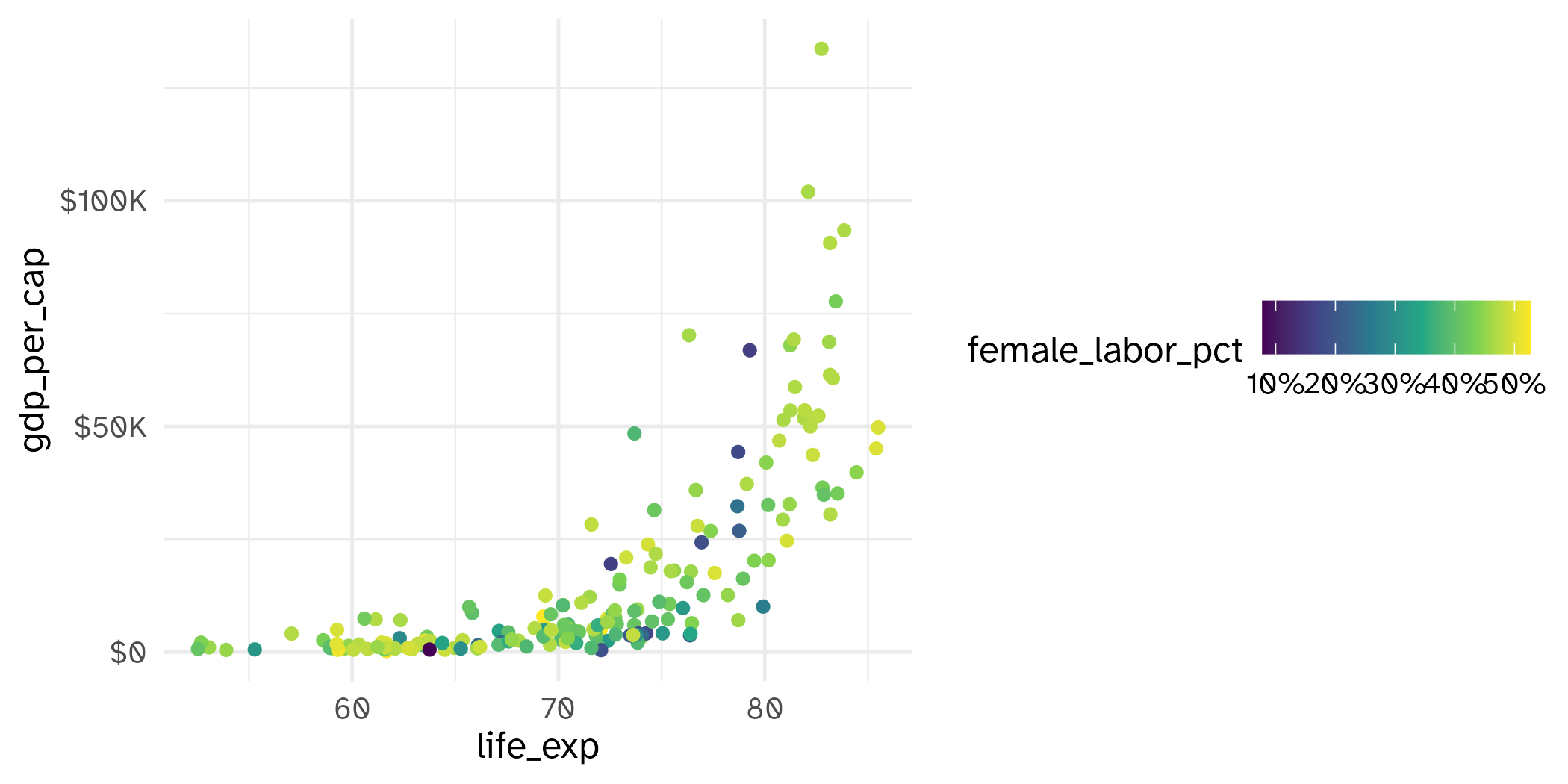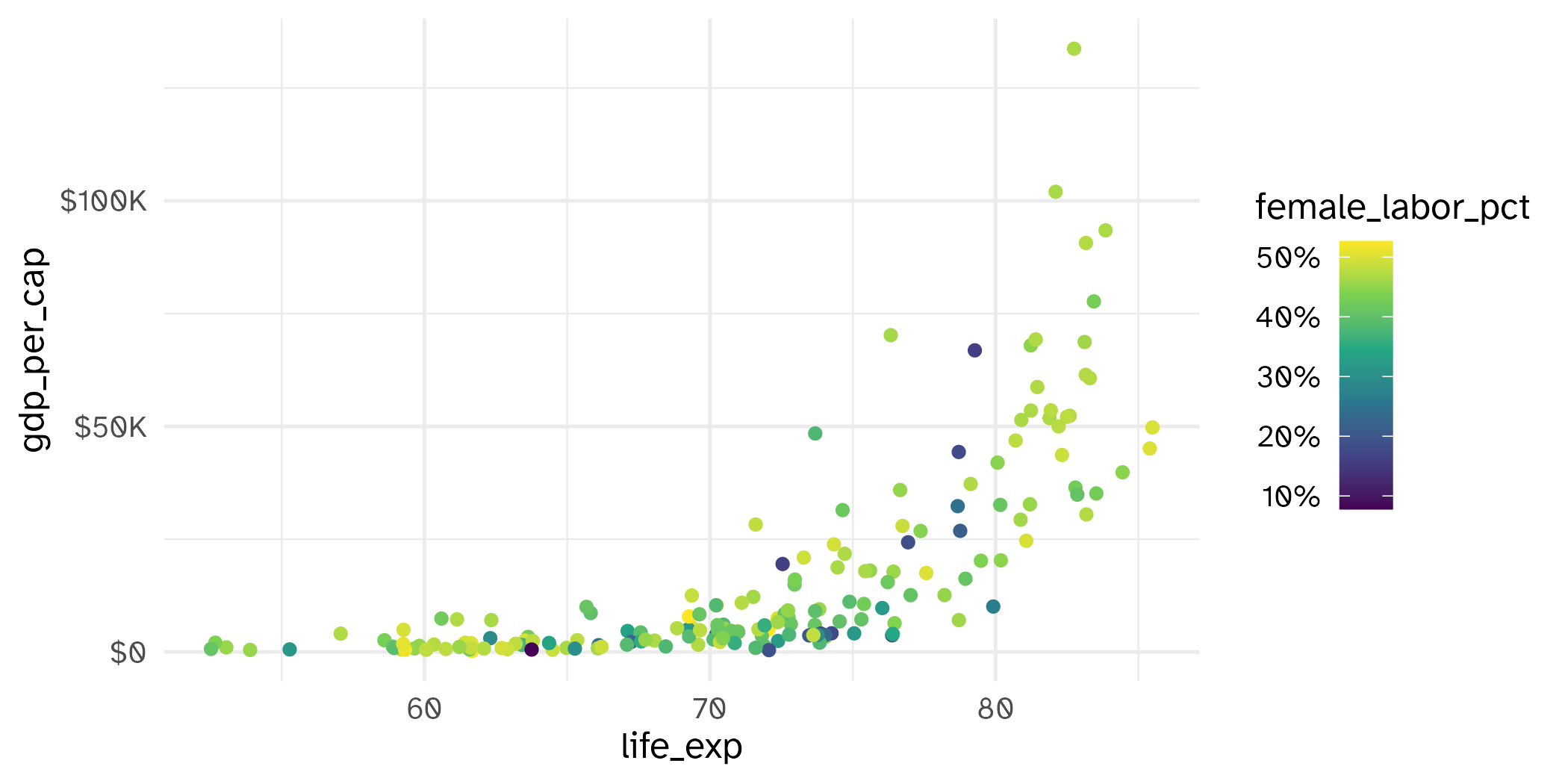# A tibble: 181 × 8
iso2c country year gdp_per_cap female_labor_pct life_exp pop income_level
<chr> <chr> <dbl> <dbl> <dbl> <dbl> <dbl> <fct>
1 AO Angola 2021 1927. 49.9 61.6 3.45e7 Lower middl…
2 AL Albania 2021 6377. 44.1 76.5 2.81e6 Upper middl…
3 AE United… 2021 44332. 17.7 78.7 9.37e6 High income
4 AR Argent… 2021 10651. 42.5 75.4 4.58e7 Upper middl…
5 AM Armenia 2021 4973. 52.7 72.0 2.79e6 Upper middl…
6 AU Austra… 2021 60697. 47.2 83.3 2.57e7 High income
7 AT Austria 2021 53518. 46.8 81.2 8.96e6 High income
8 AZ Azerba… 2021 5408. 49.9 69.4 1.01e7 Upper middl…
9 BI Burundi 2021 221. 51.9 61.7 1.26e7 Low income
10 BE Belgium 2021 51850. 46.8 81.9 1.16e7 High income
# ℹ 171 more rowsDeep dive: stats + scales + guides
Lecture 5
Cornell University
INFO 3312/5312 - Spring 2025
February 4, 2025
Announcements
Announcements
- (Tentative) Second-half topic schedule posted
- Homework 02 due tomorrow
- Project 01
Project 01
- Project description
- Team assignments on Thursday
- Deliverables
- Complete team preference survey
Visualization critique
Media bias in the United States
Source: Ad Fontes Media
Setup
World Bank indicators
Stats
Stats < > geoms
- Statistical transformation (stat) transforms the data, typically by summarizing
- Many of {ggplot2} ’s stats are used behind the scenes to generate many important geoms
stat |
geom |
|---|---|
stat_bin() |
geom_bar(), geom_freqpoly(), geom_histogram() |
stat_bin2d() |
geom_bin2d() |
stat_bindot() |
geom_dotplot() |
stat_binhex() |
geom_hex() |
stat_boxplot() |
geom_boxplot() |
stat_contour() |
geom_contour() |
stat_quantile() |
geom_quantile() |
stat_smooth() |
geom_smooth() |
stat_sum() |
geom_count() |
stat_boxplot()
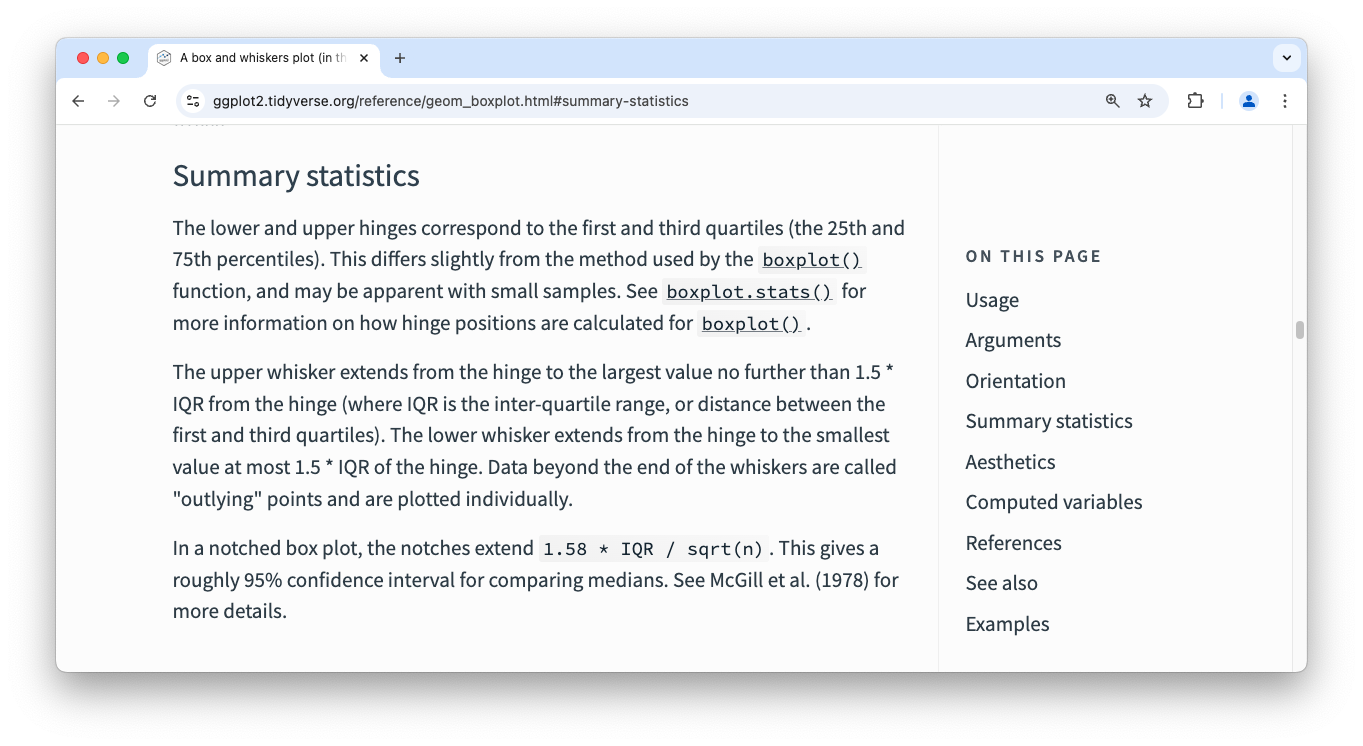
Layering with stats

Alternate: layering with stats

Alternate alternate: do it with {dplyr}

Scales
What is a scale?
Each scale is a function from a region in data space (the domain of the scale) to a region in aesthetic space (the range of the scale)
The axis or legend (also known as a guide) is the inverse function: it allows you to convert visual properties back to data
Scale specification
Every aesthetic in your plot is associated with exactly one scale:
Anatomy of a scale function
scale_<aes>_<type>()
- Always starts with
scale <aes>: Name of the primary aesthetic (e.g.,color,shape,x)<type>: Name of the scale (e.g.,continuous,discrete,brewer)
Guess the output
What will the x-axis label of the following plot say?
“Address” messages
Scale for x is already present.
Adding another scale for x, which will replace the existing scale.
What happens if incorrect pairing?
Error in `scale_x_continuous()`:
! Discrete values supplied to continuous scale.
ℹ Example values: Lower middle income, Upper middle income, High income, Upper
middle income, and Upper middle income
Transformations
When working with continuous data, the default is to map linearly from the data space onto the aesthetic space, but this scale can be transformed
Common scale transformations
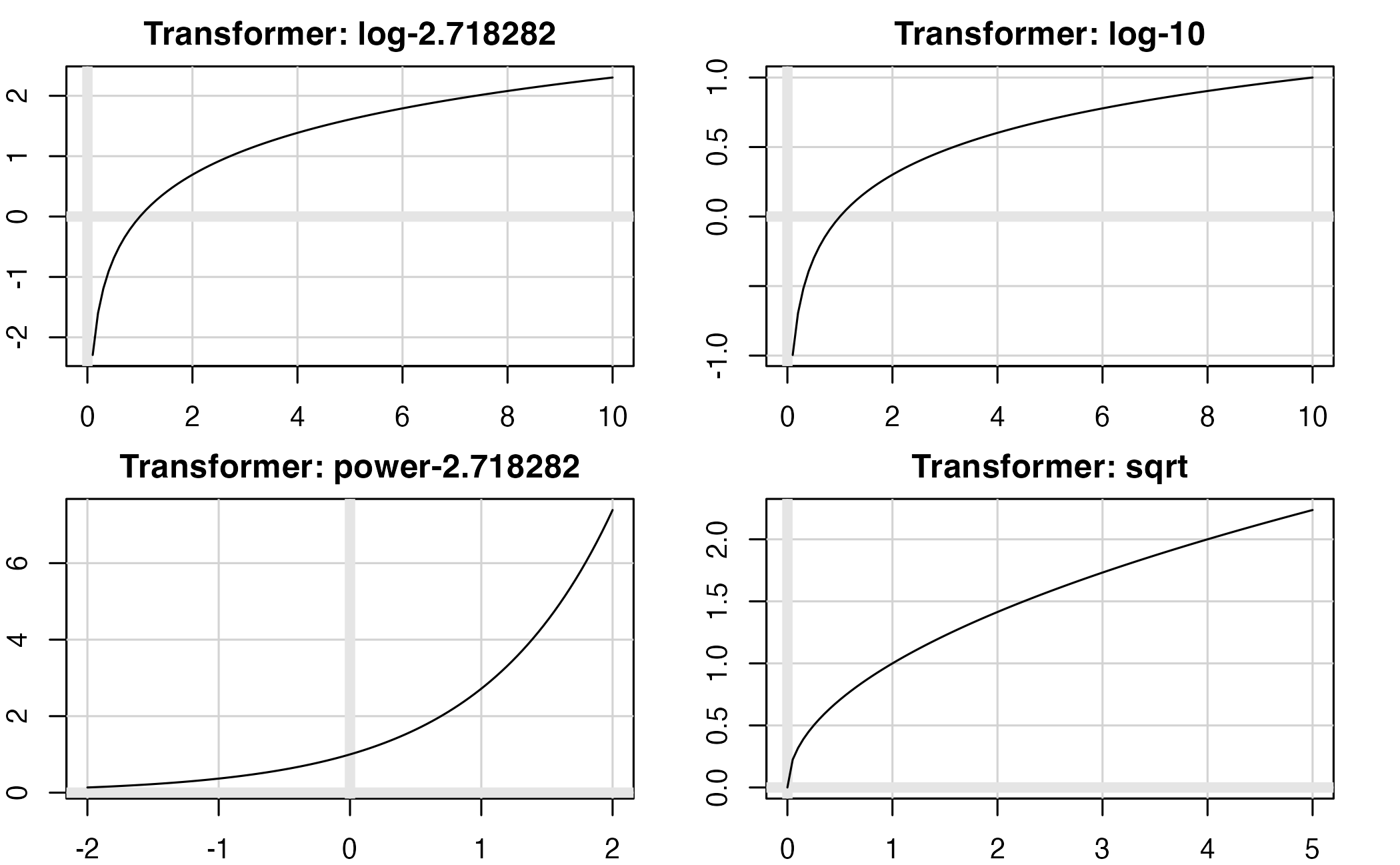
Box-Cox scale transformations
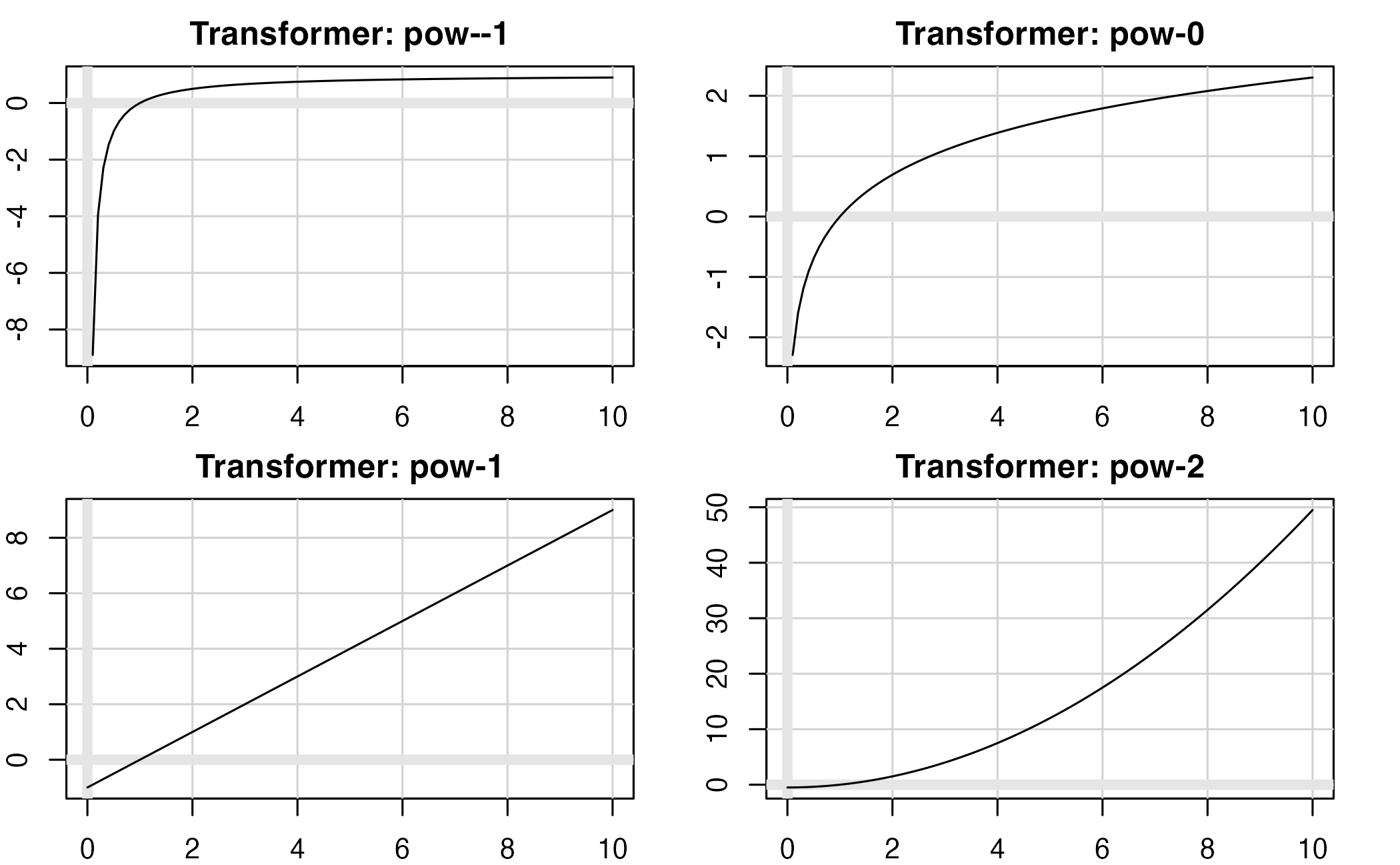
Continuous scale transformations
| Name | Function \(f(x)\) | Inverse \(f^{-1}(y)\) |
|---|---|---|
| asn | \(\tanh^{-1}(x)\) | \(\tanh(y)\) |
| exp | \(e ^ x\) | \(\log(y)\) |
| identity | \(x\) | \(y\) |
| log | \(\log(x)\) | \(e ^ y\) |
| log10 | \(\log_{10}(x)\) | \(10 ^ y\) |
| log2 | \(\log_2(x)\) | \(2 ^ y\) |
| logit | \(\log(\frac{x}{1 - x})\) | \(\frac{1}{1 + e(y)}\) |
| pow10 | \(10^x\) | \(\log_{10}(y)\) |
| probit | \(\Phi(x)\) | \(\Phi^{-1}(y)\) |
| reciprocal | \(x^{-1}\) | \(y^{-1}\) |
| reverse | \(-x\) | \(-y\) |
| sqrt | \(x^{1/2}\) | \(y ^ 2\) |
Convenience functions for transformations
Application exercise
ae-04
Instructions
- Go to the course GitHub org and find your
ae-04(repo name will be suffixed with your GitHub name). - Clone the repo in RStudio, run
renv::restore()to install the required packages, open the Quarto document in the repo, and follow along and complete the exercises. - Render, commit, and push your edits by the AE deadline – end of the day
Work through part 1
Implement log transformations.
07:00
Guides
What is a guide?
Guides are legends and axes:
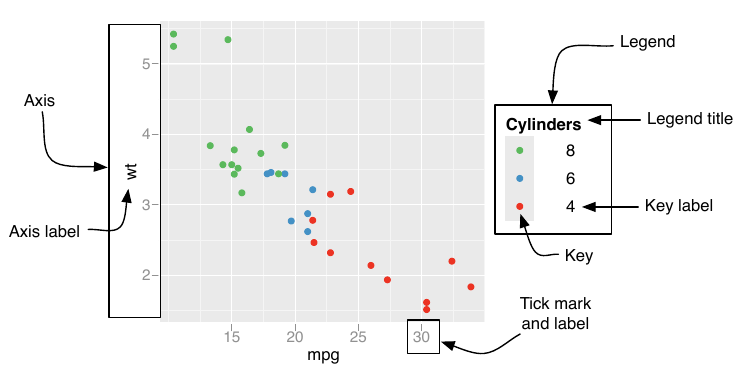
Source: ggplot2-book Chp 14.
Customizing axes

Customizing axes
Why do 50 and 90 not appear on the \(y\)-axis?
Customizing axes
Customizing axes
ggplot(world_bank, aes(x = gdp_per_cap, y = life_exp)) +
geom_point(alpha = 0.5) +
scale_y_continuous(
name = "Life expectancy at birth",
breaks = seq(from = 50, to = 90, by = 10),
limits = c(50, 90)
) +
scale_x_continuous(
name = "GDP per capita",
breaks = c(0, 5e04, 1e05),
labels = c("$0", "$50,000", "$100,000")
)
Customizing axes
Customizing axes
ggplot(world_bank, aes(x = gdp_per_cap, y = life_exp)) +
geom_point(alpha = 0.5) +
scale_y_continuous(
name = "Life expectancy at birth",
breaks = seq(from = 50, to = 90, by = 10),
limits = c(50, 90)
) +
scale_x_continuous(
name = "GDP per capita",
labels = label_currency(scale_cut = cut_short_scale())
)
Modifying scale guides
Scale guides
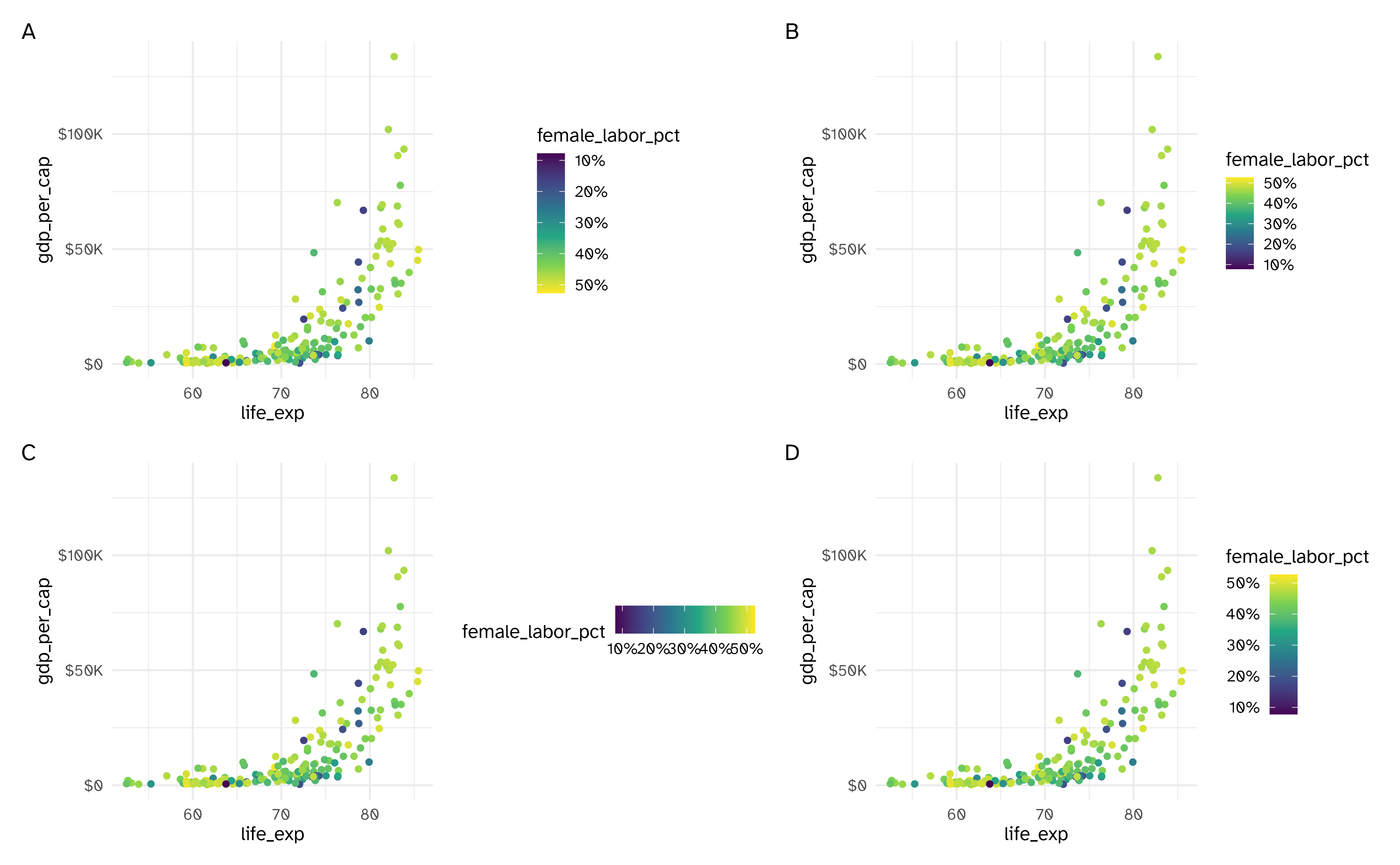
Scale guides
| Scale type | Default guide type | Function |
|---|---|---|
| Continuous scales for color/fill aesthetics | colorbar | guide_colorbar() |
| Binned scales for color/fill aesthetics | colorsteps | guide_colorsteps() |
| Position scales (continuous, binned and discrete) | axis | guide_axis() |
| Discrete scales (except position scales) | legend | guide_legend() |
| Binned scales (except position/color/fill scales) | bins | guide_bins() |
Example implementation
Application exercise
ae-04
Work through part 2
Recreate this plot.
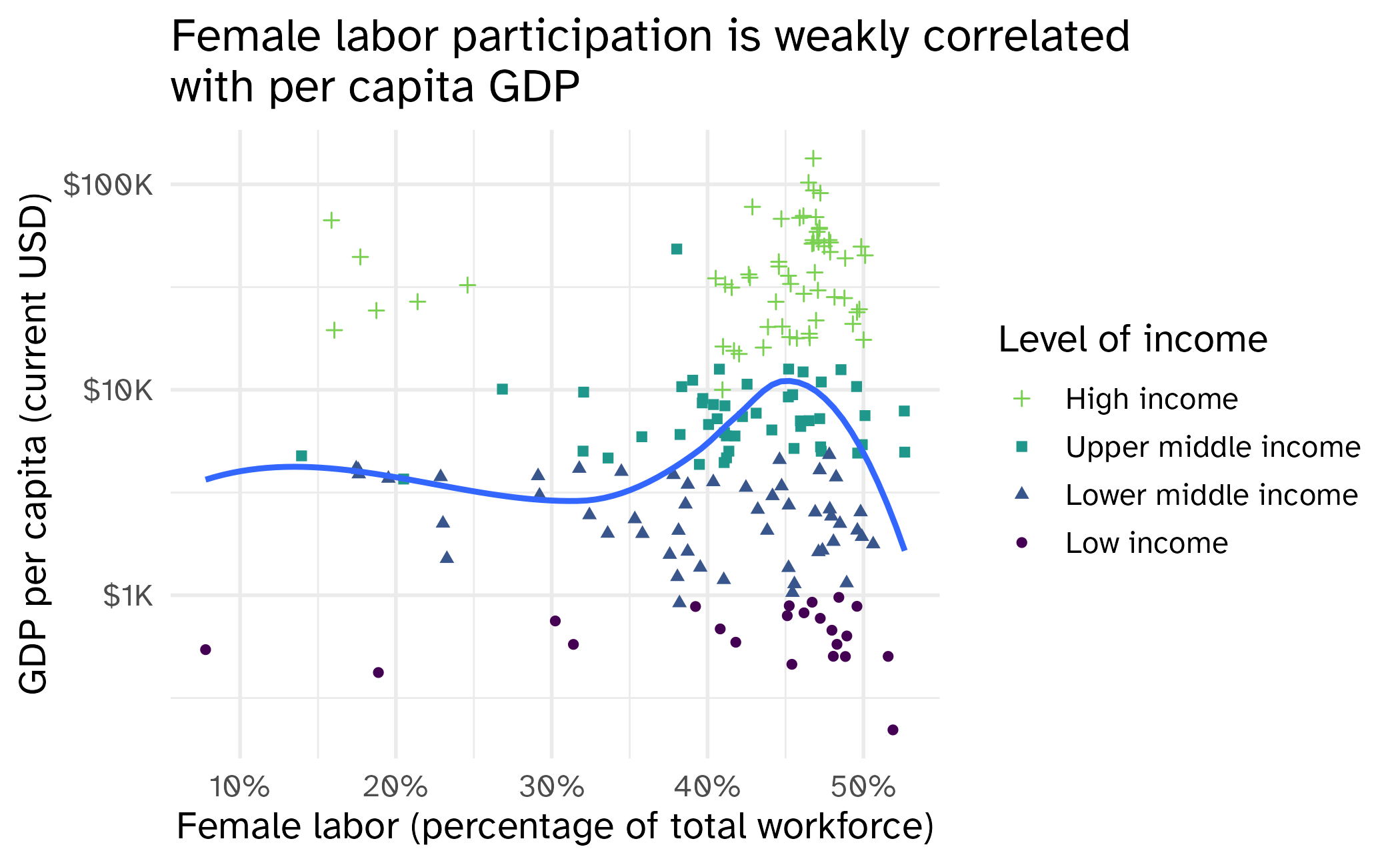
10:00
Wrap up
Recap
- {ggplot2} implements statistical transformations (typically as defaults)
- Scales visually encode data to mappings
- Guides control the appearance of scales
- {scales} package provides a wide range of transformation and formatting functions
- Use
guide_*()functions to customize the appearance of guides
Acknowledgements
- Slides derived in part from STA 313: Advanced Data Visualization









